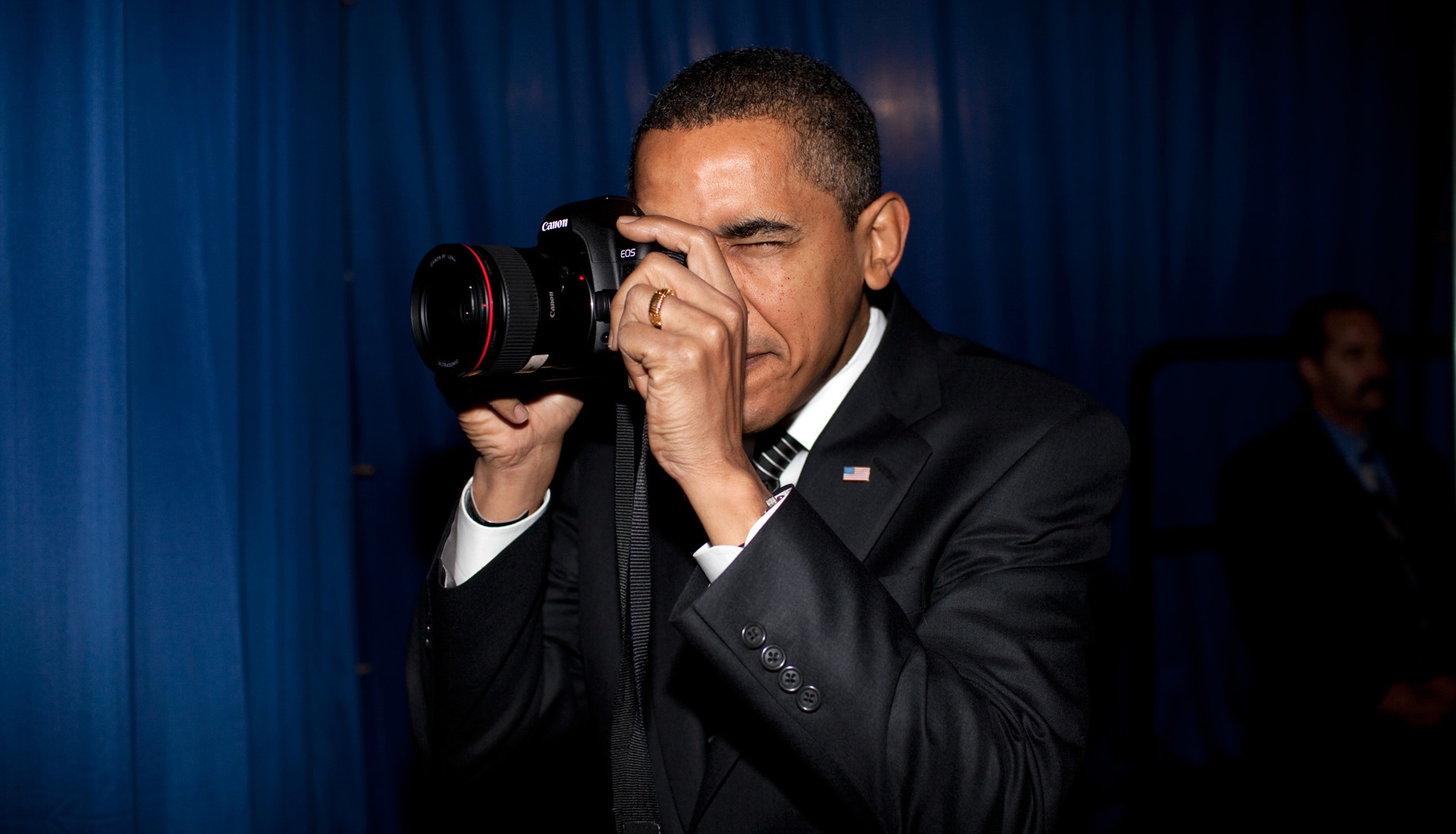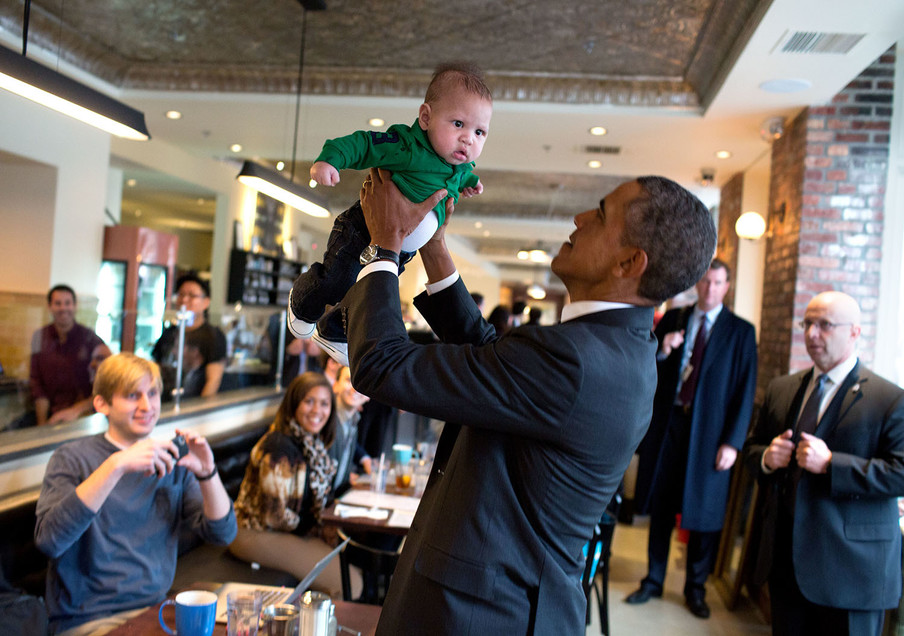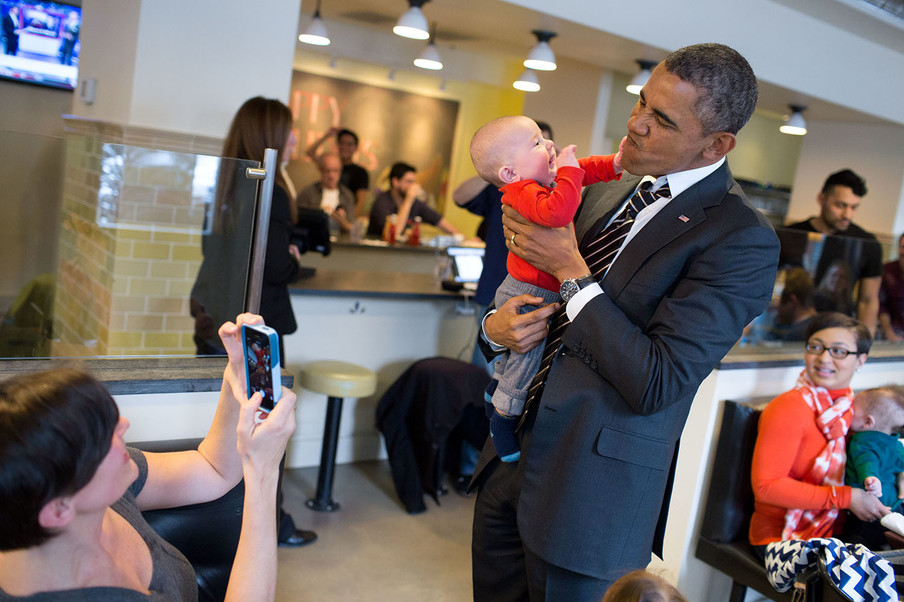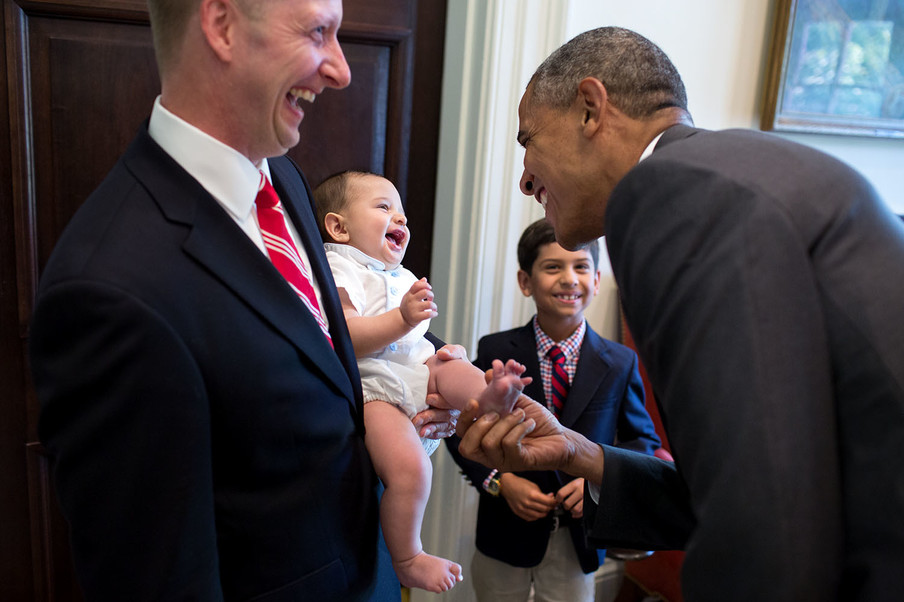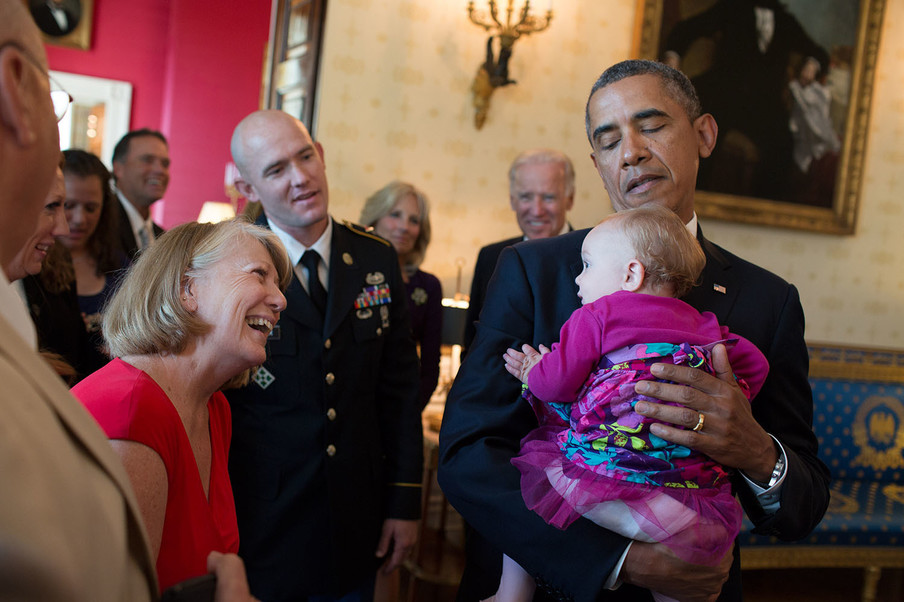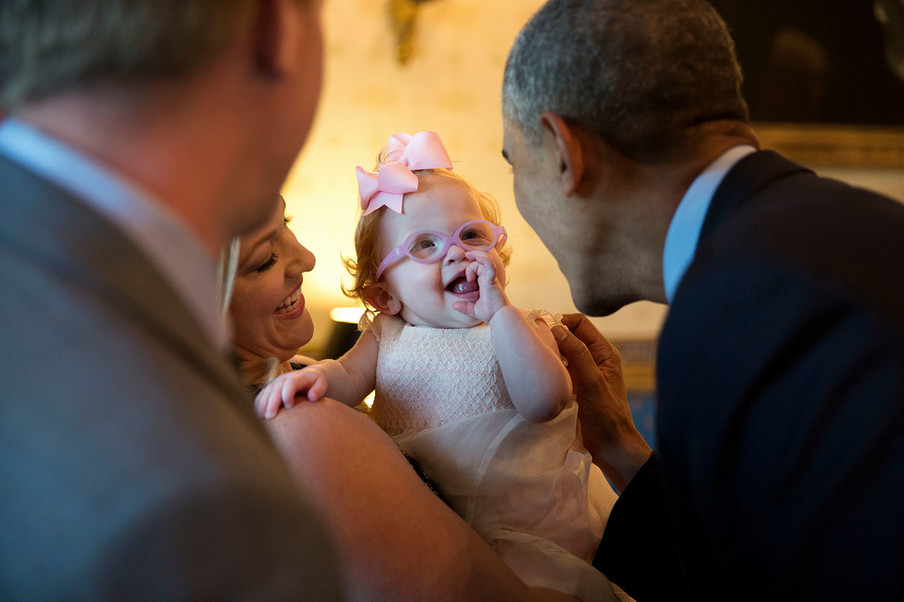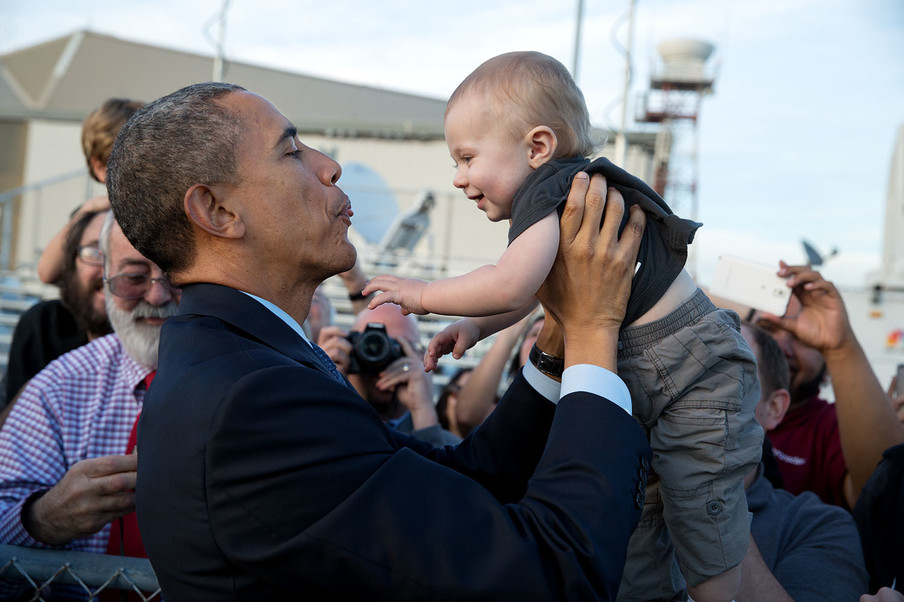Funny, what happens to photos. Though they display the exact same images they captured years ago, their meaning nonetheless changes. What started out as news photos of Barack Obama become relics of his presidency. And now that Donald Trump has become his successor, photos of Obama will never be the same.
What we see determines our perception. What we see informs our opinions and ideas about the world. So it only makes sense that presidents want to exert control over the images of them that we see.
For eight years, official White House photographer Pete Souza took roughly 20,000 photos every week
Never before has a president let so many photos of himself be taken and shared. For eight years, official White House photographer Pete Souza took roughly 20,000 photos every week. A selection of pictures were regularly added to the White House’s official Flickr photostream.
I spent years sifting through those photos, looking for patterns. Because in the themes that repeat, we can discern the careful, deliberate shaping of our view of Obama. When you look at a single photo, it seems to capture a unique moment, as if by chance. That’s how we interpret news photos, as specific one-time events. But when you see a photo in a gallery filled with similar images, you catch a glimpse of the intention behind it.
Now at the end of his presidency, it’s time to draw up the balance. Which facets of Obama’s image have endured to the end? What stands out? And what does that say about the way we’ll remember this president?
Obama and the secret of his love
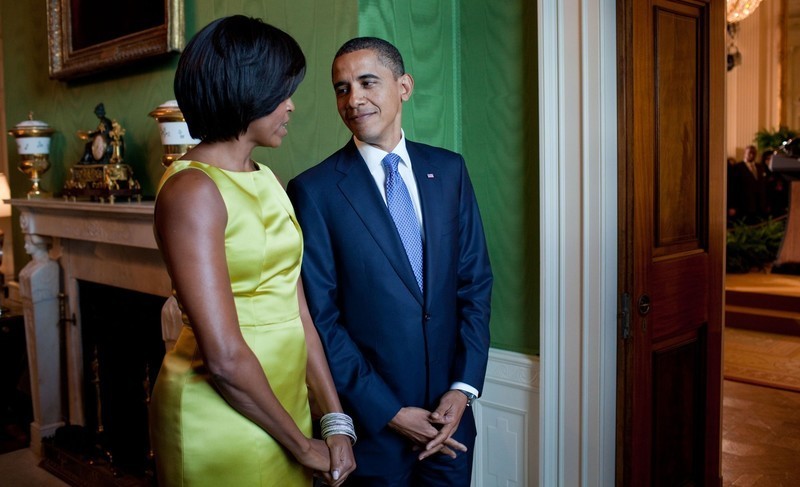
There you sit, as the wife of. Your husband wanted to become the most powerful man in the world, and darned if he didn’t do it. His career now determines yours. You have a role to fulfill, because the first lady is the quiet power that feeds her husband’s success. She’s his pillar of strength, she’s always there for him, and she’s the mother of his children. Standing next to her, he can express his loving, caring, loyal side.
This collection portrays Michelle at Barack’s side. As the president’s wife, during official occasions. And as his wife, in the private moments.


The first lady
While the whole world watches, Barack embraces his wife on stage. Even if he’s just given the worst speech of his life, she’ll always return his embrace. At least while the cameras are there and everyone’s watching. Here, Michelle fulfills the role that’s expected of her. The way it should be done. A woman who stands by her man. Her loving, well-groomed, and authentic presentation reflects well on him. She accentuates his good qualities and, behind the scenes, can keep him from making poor decisions.
Not that the love is any less genuine or should be kept hidden, but it serves a different function
Every couple knows the difference between intimacy alone and intimacy in public. A kiss and an affectionate embrace feel different when there’s an audience. It often feels awkward. The gesture of love becomes more demonstrative, more of a statement. Not that the love is any less genuine or should be kept hidden, but it serves a different function. It’s evidence. The way a bride and groom kiss to seal their newly sworn undying love and everyone may cheer its success.
Barack no longer needs to stake his claim to her; he has no competition to fear. But it’s important that he continually show that he loves her and that their relationship is healthy. Because any whiff of disinterest or rejection can take on a life of its own in the tabloids. You argue on your own time. In public, love’s part of the job.
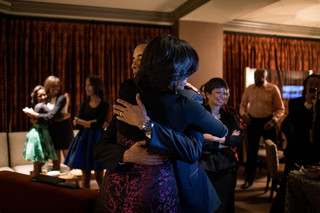

The woman
Obama usually does most of the talking when they appear in public. But every now and then, Michelle emerges from his shadow and all eyes are trained on her. At those times, Barack literally takes a step back. He, too, has his eyes trained on her. He’s proud of her. He looks at this beautiful woman with enjoyment, aware that none of the cameras present will leave him out of the frame.


His wife
The major difference between the photos taken by press photographers and those taken by Souza is that he may also photograph the first couple during private moments. That means he can record those times when Michelle and Barack are briefly alone together.
Here, he’s captured a glimpse of a playful and loving couple. We can see they’re still aware that others are around; their body language is a little reserved. But precisely the fact that they seek out each other’s company in these non-ceremonial moments is a point in love’s favor.
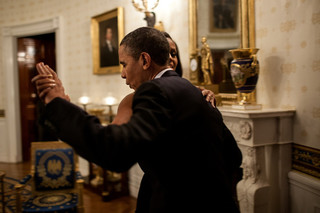
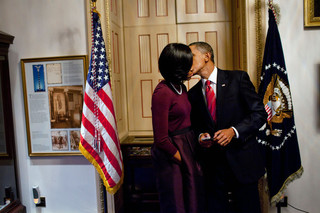
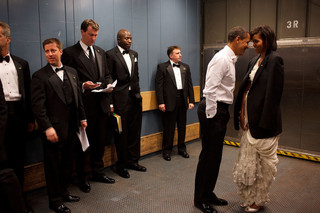


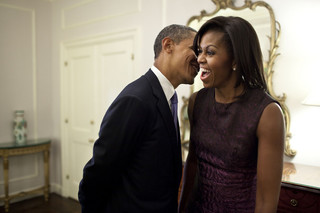
His beloved
Deliberate or not, this is a heartwarming collection. The shaping of perception doesn’t have to be forced and inauthentic.
With the photos side by side, a pattern emerges. It relates to the way Barack seeks contact with his wife. It’s subtle, and so natural in each individual photo that we don’t even notice it.
But look closely. He’s always the one who seeks contact. He puts an arm around her and gives her a kiss. He makes her laugh. He leans toward her and places his forehead against hers. And she always accepts his affection. By leaning in to meet him, relaxing into his arms, laughing at his joke, or playfully pushing him away. A subtle detail that speaks volumes. They have clear and comfortable roles. This is the secret of their love.
Obama, his vista, and yearning
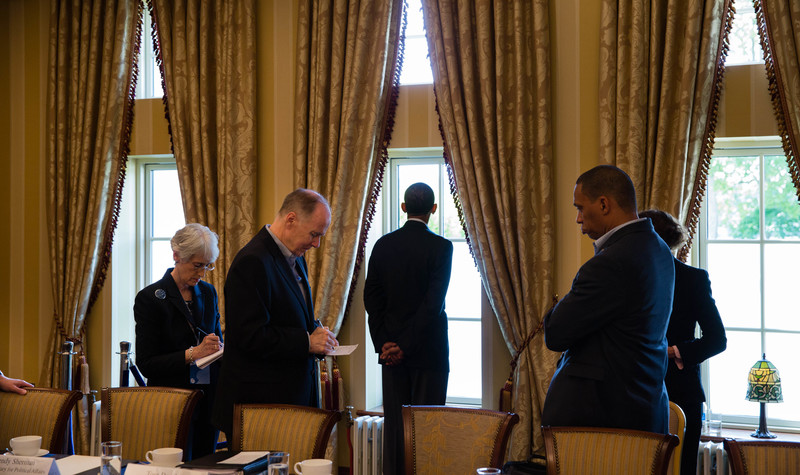
A man stands by the window and looks outside. Has something terrible just transpired? Is he waiting for something? Is he enjoying the way the trees rustle in the wind? Is he lost in thought? Or is he checking the weather, because it’s time to walk the dogs?
These images show little, thereby evoking all the more. This collection is about that poetic evocation.


You almost don’t see that it’s Obama in the photos. The distance from which he’s been photographed makes him small in the surrounding space. Just as paintings in the Romantic era portrayed man as an insignificant creature among nature’s extravagant wonders, so this collection embeds the president’s physical presence within the light of his immense obligations.
And you can literally see it in the photos. In some of them it seems dark inside, but it won’t actually have been so in reality. Contrast, heightened by backlighting, is one of a photographer’s tools. Objects that are easy to see with the naked eye become silhouettes in the backlit photograph. The dark images are mysterious. Heavy, and charged with meaning. He must be thinking deep thoughts here. Aesthetics is a valuable tool in shaping perception.
The neoclassical interiors make the rooms stately spaces tinged with history. Amid all that majesty and might stands a man in repose. He usually has his hands in his pockets, or clasped behind his back. Though there are plentiful windows in every room, he clearly has his favorites. These are no doubt influenced by the view, which is obstructed by trees from some of the windows.

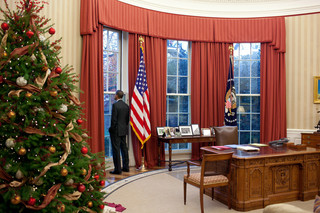
Sometimes he seems more like he’s staring into the distance, leaning back with his face turned to the sky. At other times he leans forward, as if he’s focused on something specific. But what exactly has caught his eye, we don’t know. That’s precisely the power of these images. A window suggests an outside world. Where a door provides access to that outside world, a window is transparent and simultaneously a hermetically sealed barrier. Inside there are rules; outside, carefree liberty. Did Obama sometimes wish he weren’t the president, just for a day?
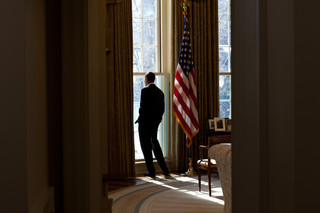

The feeling is us-and-them. There’s no contact. Whatever happens inside, everything will go on undisturbed out there. And vice versa: even if it’s snowing outside, the president can walk around in his swimming trunks all day if he wants to. But the president’s clothes never betray the season; inside, it’s always the same temperature. Only details such as a Christmas tree provide a sense of the passage of time.
He usually seems to be alone in the room, but at the edge of the image or in the reflection of the glass, we glimpse other people. So it won’t always have been as quiet as the images suggest.

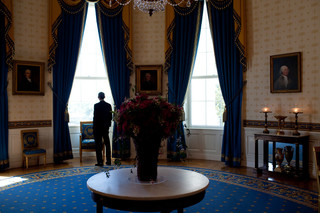
That us-and-them feeling is, in Obama’s case, actually a me-and-them feeling. That’s what the photos in this collection portray. The neoclassical decor of the spaces: he’s following in his predecessors’ footsteps. The president small, the windows gigantic: he’s offered his life in service of his task. The trick with the light: his duties are weighty. The lonesome staring at the untroubled outside world: only he and his predecessors know the weight of this momentous duty.
It’s lonely at the top.
Obama and his infectious laugh

Imagine you’re meeting the president of the United States for the first time. The first few minutes are a little awkward. Your gaze wanders the room. The Oval Office really does look just like it does in the photos. And so does President Barack Obama, actually. And though he’s gracious and welcoming, the powerful decor remains intimidating.
Fortunately, the shine on your shoes is just as bright as his. He invites you to sit, and you sink into the soft cushions. Is that bowl of apples just for show? The room is spotless, the placement of the furniture homey, meant to make you feel at ease. And there you sit, thinking about how to start the conversation. Jump right into the heart of the matter, or start off with a little small talk?

Then, suddenly, the president cracks a joke. You’ve been saved! With a loud guffaw you release all the tension in your body, clapping the arm of the sofa with your hand for good measure. The president watches in satisfaction as you laugh at his joke. The ice has been broken.


Smiling is constructive. Contrary to what we might expect with a job like his, President Obama does it all day long, Souza’s photos reveal. He wears a broad smile for every hand he shakes, every photo he poses for, and every state visitor he welcomes. He smiles equally at friend and foe.
A smile is a mask that can conceal entirely different emotions. It can bridge every cultural difference. But only if the smile is sincere. Certainly in a photo, which can mercilessly expose – or suggest – any fleeting instant of discomfort, that sincerity is vital.
True laughter is fundamentally different from a smile. It’s a short circuit in the brain, a physical response to something unexpected. Laughter is healthy, and it serves to defuse tensions and unite people. It’s an exuberant outlet for what takes place behind the mask.
Sincerity, spontaneity, and optimism are qualities with which the president is eager to be associated. But he can’t force either that spontaneous laughter or those associations. That’s where Souza’s photos come in. The White House photographer can capture that laugh, one of Obama’s secret weapons, for the record.
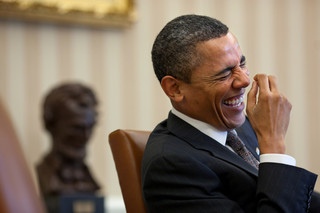
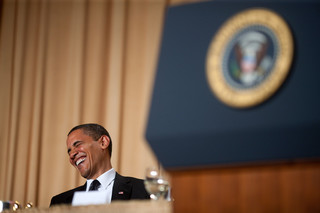
Because what is it about those photos in which Obama’s laughing? He always laughs pretty much the same way. Usually with his mouth open. His top lip moves up, revealing a row of white teeth. His cheeks fold in long dimples that reach to his chin. Double dimples even, two on each side. They accentuate his mouth and make his laugh even bigger. His head tilts. He leans his body back, so he can let the joke fully wash over him. And his eyes? Those he squeezes shut, so that there, too, long horizontal smile lines appear. It’s endearing, the president’s brief spasm, that fleeting short circuit in his head. For a moment, he lets himself go. Obama isn’t stiff; he laughs with his entire body.
In some photos, the source of Obama’s laughter is visible. Often someone’s showing him something, such as a photo or a screen, and saying something about it. But we rarely see what he’s seeing.
Maybe the people in the photograph are making fun of someone, or laughing at something we wouldn’t find funny at all. The people around Obama laugh along with him, but never as hard as he does (at least visually). It doesn’t matter what the joke is. These photos focus on the president’s exuberant laugh.


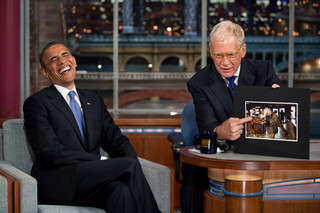
Because a president will rarely lose himself in a bout of the giggles, the moment is always brief and unexpected. That first roar of laughter is the best one; that’s the one Souza needs to capture. During that short circuit, everyone reacts instinctively. Bodies lean together, hands are placed on shoulders; some eyes search for affirmation, and in others we can read the pleasure of having their joke appreciated.
And that’s how Obama, in laughing, kills two birds with one stone. Because just as laughing together creates a feeling of community, Pete Souza’s photos also spark a connection. In looking at the photos in this collection, you’ve probably already had to smile. The photos make you feel good.
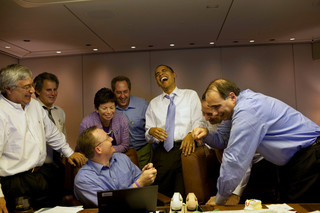


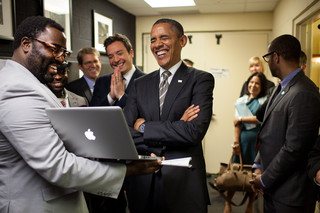

Okay, so Obama has a talent for laughter. And a talent for making others laugh. But is he also funny? And I don’t mean his scripted humor, the witty jokes he thinks up with a whole team. Nor the jokes he’s skilled at inserting into his speeches, whose resulting audience laughter he receives with visible enjoyment. Nor the jokes that are meant to break the ice. No, a genuinely funny joke, one that strikes a chord, one that’s bold and unexpected.
Humor isn’t easy to photograph, because the joke is usually told in words. But I found it, the photo that shows Obama really does have a sense of humor. This photo makes the collection complete:

Obama and the anomaly
There was one photo that stood out even from the start of my trips through the archive. The photo had its own folder, because it didn’t seem to belong anywhere. The folder never expanded; the photo remained the archive’s big anomaly.
See him standing there, the president of the United States. The most powerful man in the Western world. In front of an enormous Buddhist temple. In bare feet.

He’s excited. Surprised maybe. By the place? By his own bare feet? He’s looking straight at the camera. He’s clearly not posing; he’s still in motion. In the photo he seems to be alone, but a whole delegation has accompanied him on this visit. So why is he standing there by himself, while the rest look on? He wants to share this moment with the camera. And with anyone else who might be looking at him.
Obama is visiting Aung San Suu Kyi in Burma. One of the trip’s ceremonial obligations is a visit to Shwedagon Pagoda, a Buddhist temple complex in the city of Yangon. It’s sacred ground, and Obama must take off his shoes and socks.
This photo is unique because it differs in nearly every detail from all the other photos in Souza’s archive
We almost never see Obama photographed from head to toe by Souza. Certainly not like this. But it’s not just those bare feet that make this photo so exceptional. This photo is unique because it differs in nearly every detail from all the other photos in Souza’s archive.
Obama is surprised, and he’s sharing his amazement directly with the photographer – something he doesn’t normally do. He usually ignores Souza. That’s precisely why Souza’s images are so powerful. Souza can get right in the thick of things with his camera, knowing his presence won’t affect the situation.
But that’s different here. And from the composition, you can see that Souza’s surprised, too. He’s usually close by the president; not now. He usually frames the scene carefully. But that, too, is a little sloppy here. A lot of foreground, and the temple isn’t fully in the picture. Actually, it isn’t a very “good” (that is, aesthetically pleasing) photo at all, certainly not by Souza’s standards. The composition is too arbitrary, the president too small. All this photo really shows is a happy man in bare feet. A typical vacation photo to paste in the family album. Nothing more.
What an endearing photo, actually. So real, so sincere.
Shaping perception works
By now, I know Pete Souza’s entire White House photo archive backwards and forwards. When I see Obama on television or in the paper, a strange sense of familiarity steals over me. Simply because I’ve spent so many hours looking at him. I have the feeling I know everything about him. Or at any rate everything he’s decided I may know. Such as his current preference for blue ties, though he often wore red ones, too, in the past; which part of the sofa he prefers leaning against; his favorite hamburger; the secret of his love for Michelle.
Over the years, I stopped being surprised by each new photo Souza added to his archive; instead, it confirmed what I’d already discovered. That’s the power of pictures and repetition – of deliberately shaping perception. It creates the illusion that you’re seeing someone for who he is. You think you’re learning to know, understand, and appreciate someone.
On vacation
Back to that anomaly. How did this photo end up in the archive? I could only think of it as “the big anomaly,” until I remembered Roland Barthes’ essay “The Writer on Vacation.”
His argument there explains a contradiction that also lies hidden in this image. The only adjustment you have to make is to replace the word “writer” with “president.” It then becomes clear how this photo also helps the White House shape our view of Obama.
The catalyst for Barthes’ analysis is a photo published in the French magazine Le Figaro, which depicts a famous writer on vacation. It seems to show a very ordinary tableau. But it’s precisely that familiar, ordinary setting that gives him the opportunity to show a human side of himself:
In that ordinariness, you think you see a resemblance between the president and your own life
“The ‘naturalness’ in which our president is [was: novelists are] eternalized is in fact instituted to translate a sublime contradiction: that of a prosaic condition, produced, alas, by a quite materialistic period, and the glamorous status which bourgeois society liberally grants to its spiritual representatives (provided they remain harmless). What proves the president’s [was: writer’s] marvelous singularity is that during those famous vacations, which he fraternally shares with workmen and shop assistants, he never ceases, if not working, at least producing. A false worker, the president [was: writer] is also a false vacationer.”
In that ordinariness, you think you see a resemblance between the president and your own life. That can make you, the viewer, feel moved and flattered. Because the fact that you and Obama are both wearing a blue tie suggests a kinship. Just like the fact that he’s let himself be photographed in front of the temple looking just like you do posing in front of the Eiffel Tower.
It seems demystifying, but the opposite is true. This is a deliberate mystifying of the presidential mien. Through which Obama, too, wants to fulfill the expectations one has of a president.
“All of which leads to the same idea of the president [was: writer] as superman, a kind of differential being whom society puts in a glass case to profit from the artificial singularity which it has granted him.”
Kissing more babies than ever
This turned out to be the fastest-growing collection. Over the years, Obama has done more and more of this, and it absolutely peaks at the end of his second term. He lifts babies into the air and makes them laugh. He kisses them and rolls around on the floor with them. He lets groups of screaming children swarm all over him. You could almost forget that you’re looking at a president. And when you see the way everyone’s watching so tenderly, you know he’s racking up points.

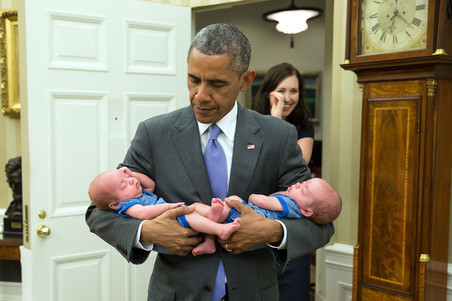


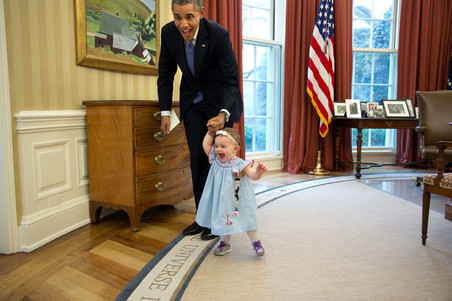
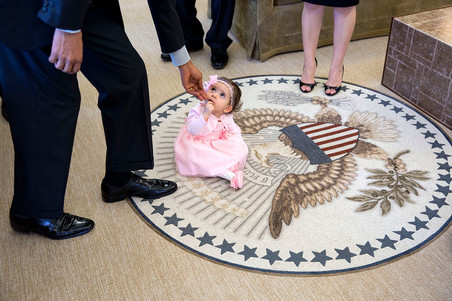



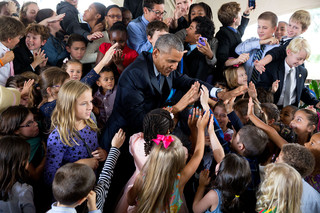

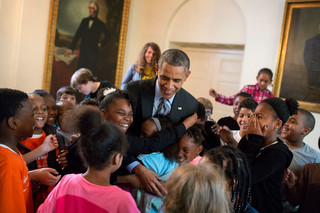
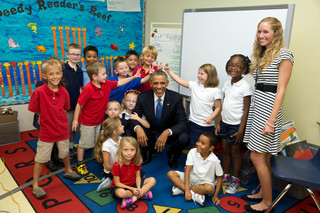
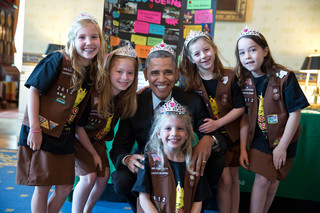
Obama really does like children; you can see that right away. But they’re also a beautiful metaphor, an excellent ingredient for shaping the public’s perception of him. Children symbolize innocence and vulnerability, opportunities and the future. And when I consider that recent increase in this type of photo, I can’t shake the thought that it has something to do with the idea of his legacy.
These children were born during Obama’s term; they are the children of his era. He worked to build the world in which they will grow up. In a broader historical perspective, it remains to be seen how profoundly he was able to steer the course of the future.
What we do know is that the contrast between him and his successor couldn’t be greater. Just as a photographer wants to be remembered for his photos, I imagine a president wants to be remembered for his deeds. Deeds that may be all the more valued – and overshadowed – by that which follows.
The open end
I felt punched in the gut when I heard that Trump would be his successor, and I saw that feeling reflected in Obama’s eyes when he received Trump in the White House. That look, that instant. It still hurts when I look at this photo:

Of course it’s nonsense to conclude that Obama is pushing through the pain here: this only captures one fleeting moment. In other photos they’re both smiling. Photos aren’t facts. Each of us can find the truth we’re looking for in them.
Photos aren’t facts. Each of us can find the truth we’re looking for in them
You might call that a failing of the medium. But I don’t see it that way. I think it’s what makes photography so incredibly good at portraying the ineffable. This specific photo makes the pain visible for me, the dismay at Trump’s election. That’s also because I’ve now seen Obama in so many of Souza’s photos that I think I know him. Which is an illusion, of course, and simultaneously the power of photographs. Since Trump’s election, I look differently at the same photos of Obama.
Like the photos of Obama staring into the distance. They show almost nothing, leaving all the more room for interpretation. Most of them were taken before Trump’s election, but hindsight makes the symbolism of this lonesome staring stronger than ever. It’s the end of an era. With at least four years of Trump ahead – which, for a photo editor, also means a whole lot of photos of Trump – looking at photos of Obama saddens me. The sun has nearly set. What will the world look like when it rises again?
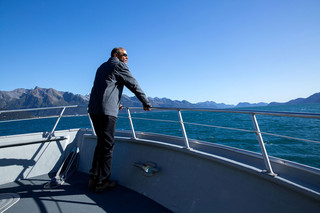


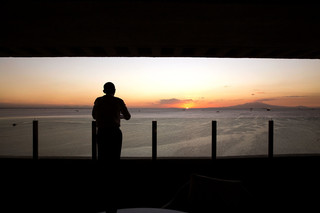

—Translated from Dutch by Grayson Morris
More from The Correspondent:
 How pictures of bonsai trees incensed our readers
Words generally come first in journalism, images are secondary. Usually. And that’s not entirely fair. A good Image Director will bypass the cliché and opt for the unexpected, to enrich stories in new ways. But when I chose bonsai photos for a story on the hidden life of trees, this approach led to unexpectedly intense reactions.
How pictures of bonsai trees incensed our readers
Words generally come first in journalism, images are secondary. Usually. And that’s not entirely fair. A good Image Director will bypass the cliché and opt for the unexpected, to enrich stories in new ways. But when I chose bonsai photos for a story on the hidden life of trees, this approach led to unexpectedly intense reactions.

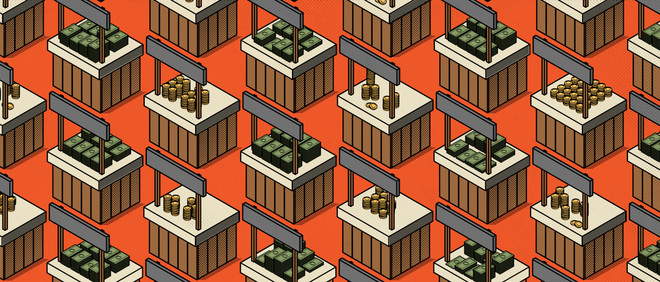 The bizarre tale of President Nixon and his basic income bill
In 1969 President Richard Nixon was on the verge of implementing a basic income for poor families in America. It promised to be a revolutionary step – had the President not changed his mind at the last minute. This is the incredible and largely forgotten tale of just how close the U.S. came to stamping out poverty altogether.
The bizarre tale of President Nixon and his basic income bill
In 1969 President Richard Nixon was on the verge of implementing a basic income for poor families in America. It promised to be a revolutionary step – had the President not changed his mind at the last minute. This is the incredible and largely forgotten tale of just how close the U.S. came to stamping out poverty altogether.

 Meet the greatest anti-poverty crusader you’ve never heard of
Every news item you read about poverty owes its existence to the work of one unknown but revolutionary economist. Oddly enough, he’s never gotten the media attention he deserves. Who is this Martin Ravallion, the man who put poverty on the map worldwide?
Meet the greatest anti-poverty crusader you’ve never heard of
Every news item you read about poverty owes its existence to the work of one unknown but revolutionary economist. Oddly enough, he’s never gotten the media attention he deserves. Who is this Martin Ravallion, the man who put poverty on the map worldwide?



